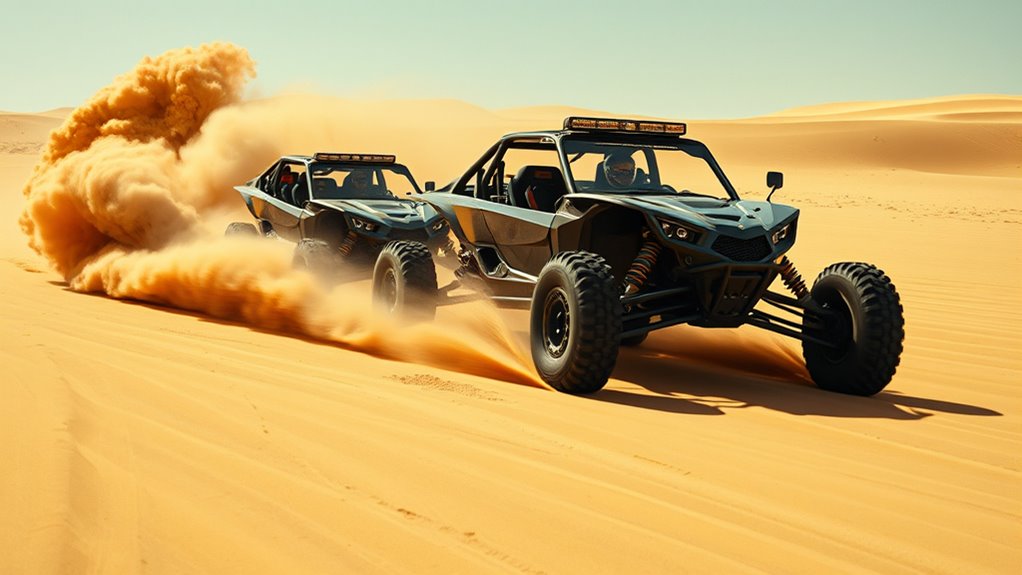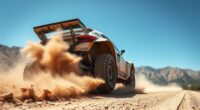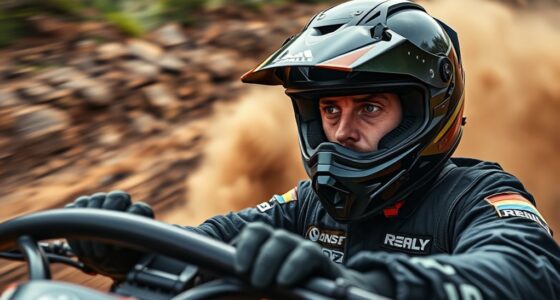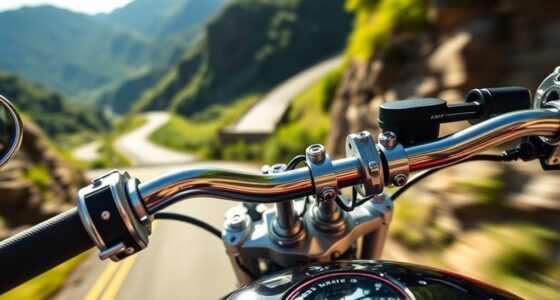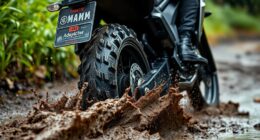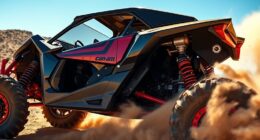In sand riding, torque is more critical initially because it provides the immediate twisting force needed to overcome loose surfaces and get your vehicle moving. Horsepower, on the other hand, helps maintain speed once you’re moving, especially on flat terrain or descents. For conquering dunes and tough terrain, you’ll want a good balance, but understanding how each influences performance can give you a serious advantage—keep exploring to uncover even more tips.
Key Takeaways
- Torque is critical for initial movement and overcoming resistance in soft sand, making it essential for starting and climbing dunes.
- Horsepower sustains high speeds and efficient trail riding once momentum is established, aiding in maintaining control over flat terrain.
- In sand conditions, high torque prevents wheel spin and bogging, while horsepower helps with acceleration and maintaining speed.
- Both are important; torque provides immediate pulling power, whereas horsepower ensures sustained performance and top speed.
- Optimizing both torque and horsepower through proper tuning and setup enhances overall off-road capability in sandy terrains.
Understanding the Basics: What Is Horsepower?
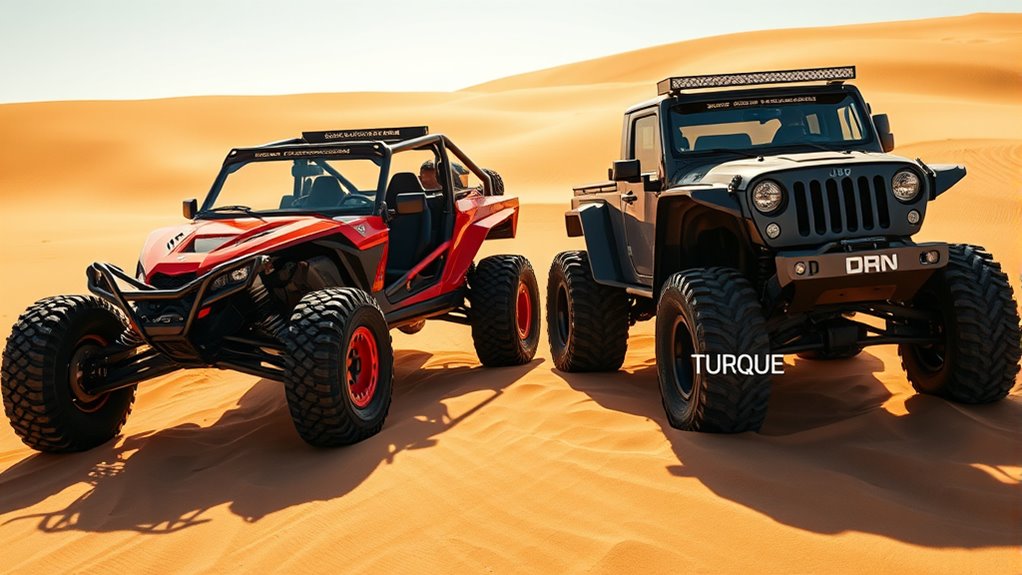
Horsepower is a unit of measurement that indicates how quickly work can be done by an engine. When you hear about a vehicle’s horsepower, think of it as a way to gauge its potential to perform tasks fast. The higher the horsepower, the more power the engine has to generate speed and acceleration. It’s calculated based on both force and how quickly that force is applied over time. Think of it as a combination of strength and speed, showing how efficiently an engine can produce movement. This measurement helps you compare engines and understand their capabilities, especially for tasks like towing, racing, or off-roading. Essentially, horsepower tells you how much work your engine can do over a specific period. Understanding the role of torque in performance] can also provide a more complete picture of an engine’s capabilities.
Demystifying Torque: The Force Behind the Spin
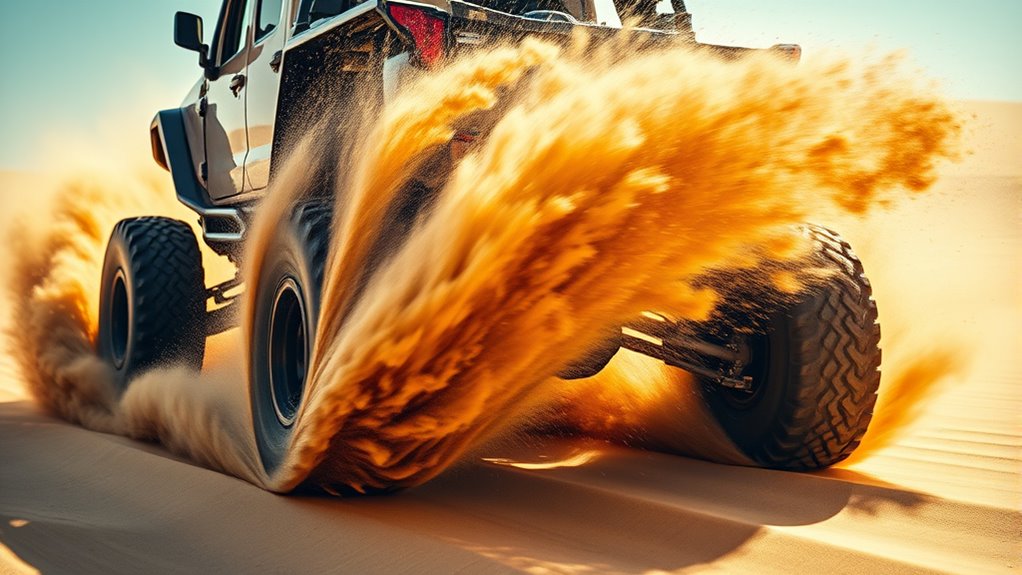
While horsepower measures how quickly work can be done, torque is the force that actually makes things turn. It’s the twisting power you feel when you spin a wrench or accelerate your vehicle. Torque is generated by the engine’s pistons pushing against the crankshaft, creating rotational force. The higher the torque, the more force you have to turn heavy loads or overcome resistance. In off-road driving, especially in sand, torque helps your vehicle push through loose terrain and get moving from a standstill. It’s essential for getting your vehicle moving and maintaining momentum in tough conditions. Without enough torque, even a powerful engine might struggle to get through challenging terrain. Understanding tuning laws can help optimize your vehicle’s torque output for better performance in demanding environments. So, torque is the force that directly influences your vehicle’s ability to spin and conquer rugged trails.
How Horsepower and Torque Work Together on Sand Trails
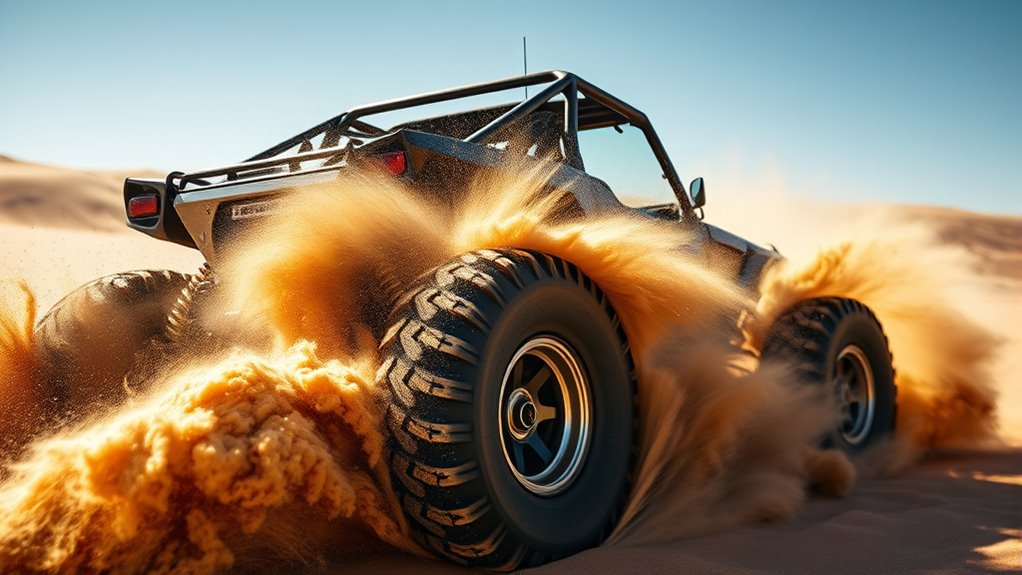
On sand trails, your vehicle relies on the synergy between horsepower and torque to perform effectively. Torque delivers the immediate force needed to start moving and maintain traction as you navigate loose surfaces. It helps you break free from stops and keeps you moving over uneven terrain. Horsepower, on the other hand, determines how quickly your vehicle accelerates and maintains speed once you’re up and running. Together, they ensure smooth, controlled progress across challenging sand. High torque helps you get moving without bogging down, while strong horsepower keeps you pushing forward at higher speeds. If either is lacking, you risk getting stuck or losing momentum. Understanding how they work together helps you choose the right vehicle and adjust your driving style for optimal performance on sand trails.
The Impact of Power on Off-Road Performance
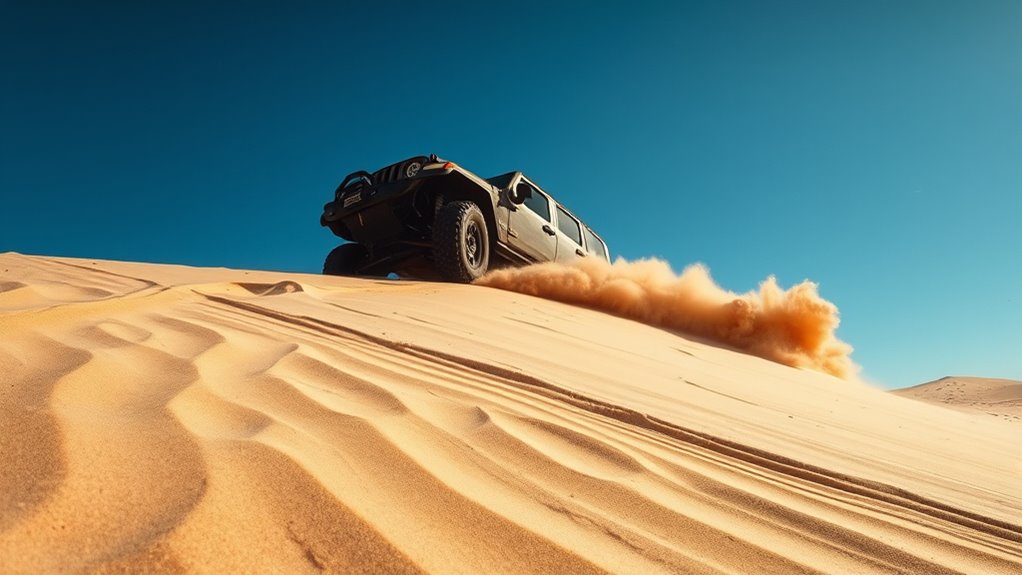
Your vehicle’s power directly affects how well it grips the terrain and moves over obstacles. Strong engine response means quicker acceleration and better traction when you need it most. Understanding these factors helps you optimize off-road performance and handle tough conditions confidently.
Power and Traction
Power plays a crucial role in off-road performance by directly affecting how well a vehicle can grip and move over challenging terrain. When you have ample power, your vehicle can generate enough force to overcome obstacles like loose sand, mud, or rocky surfaces. This power helps maintain traction, preventing wheels from spinning uselessly and losing grip. With more power, you can apply steady, controlled force to keep your tires planted on the ground, enhancing stability and momentum. Additionally, wall organization systems can optimize space, ensuring your vehicle is well-prepared for off-road adventures. However, too much power without proper traction control can cause wheel spin, reducing efficiency. Ultimately, the right balance of power and traction allows you to navigate tough terrains confidently, ensuring your vehicle maintains grip, prevents slippage, and keeps you moving forward smoothly.
Engine Response Dynamics
Engine response dynamics determine how effectively a vehicle’s power translates into movement over rugged terrain. When you’re steering through uneven sand, quick throttle response and smooth power delivery are crucial. Your engine’s responsiveness affects how rapidly your vehicle accelerates, maintains momentum, and reacts to terrain changes. Incorporating vintage decor elements can also influence the aesthetic of your vehicle’s interior, creating a nostalgic feel that complements its performance. A well-tuned engine with sharp response helps you avoid bogging down or stalling, especially when climbing dunes or maneuvering tight spots. Better response means you stay in control, conserve energy, and maximize your off-road performance.
Which Metric Is More Critical for Dune Adventures?
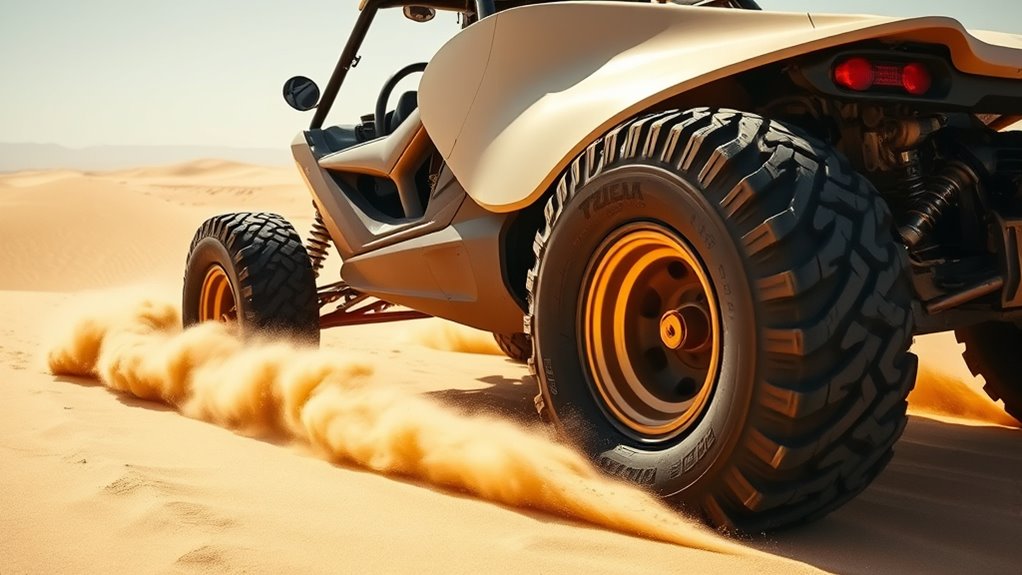
When tackling dune adventures, understanding whether horsepower or torque matters more can make a significant difference in your experience. Torque is essential because it provides the low-end power needed to start moving over soft sand and climb steep dunes. You’ll want high torque to get your vehicle moving smoothly through challenging terrain. Horsepower, on the other hand, becomes important for maintaining speed once you’re already up and running, especially on flat sections or when descending. For dune riding, a strong torque ensures you can handle the initial push through difficult spots, while horsepower helps you sustain momentum. Ultimately, both metrics matter, but if you’re tackling steep dunes and soft sand, prioritize torque for better control and capability. Additionally, understanding vehicle performance metrics can help you choose the right setup for optimal dune conquest.
Matching Your Vehicle’s Powertrain to Your Off-Road Goals
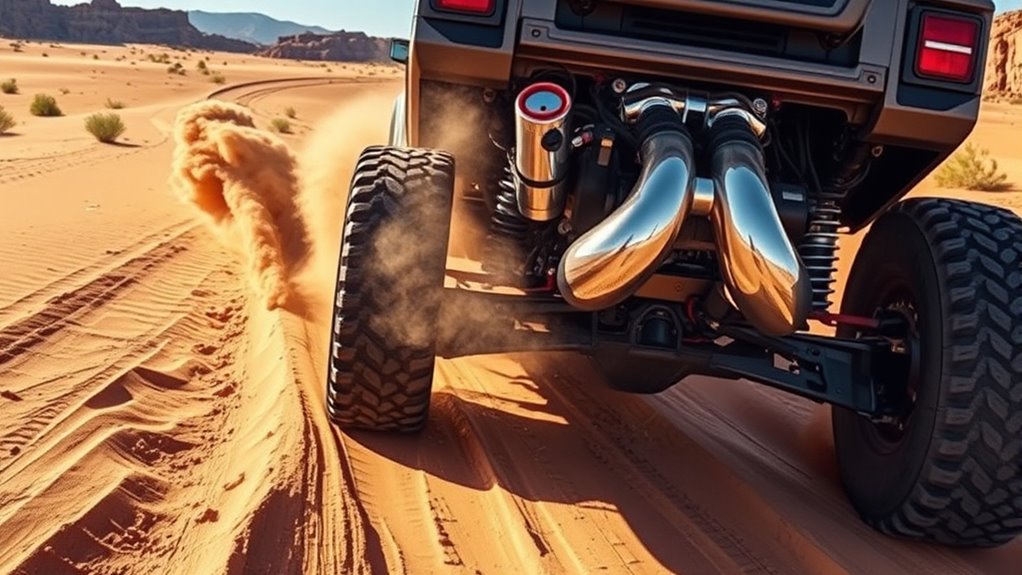
Choosing the right powertrain for your off-road adventures depends on your specific goals and terrain. To match your vehicle’s capabilities to your needs, consider these factors:
- Terrain Type: If you’re tackling steep inclines or rocky trails, a low-end torque setup provides better control and power at low speeds. For open dunes, higher horsepower helps you reach top speeds quickly.
- Driving Style: If you prefer crawling over obstacles, a torque-heavy engine offers better low-speed power. For fast, aggressive rides, a higher horsepower engine delivers the speed and responsiveness you want.
- Vehicle Modifications: Upgrades like lift kits or tires can influence your powertrain choice, ensuring your setup complements your terrain and driving style.
Matching your powertrain guarantees ideal performance and control in the sand.
Tips for Optimizing Horsepower and Torque for Sand Riding
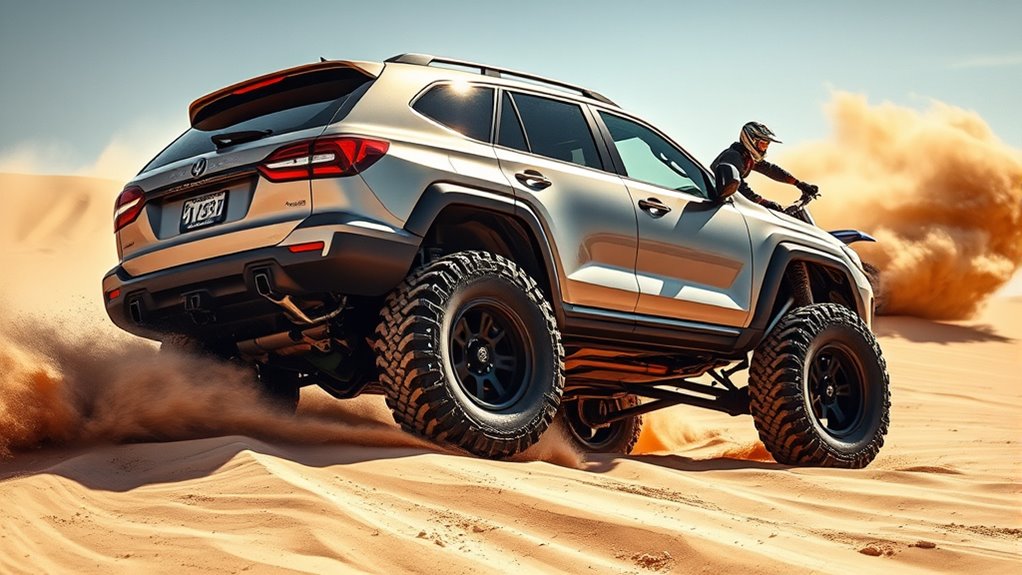
To get the most out of your sand riding experience, you need to fine-tune your vehicle’s horsepower and torque. Adjusting gear selection, engine tuning, and your tire and suspension setup can make a big difference. Let’s explore practical tips to optimize your ride for maximum performance on the sand. For example, Kia Tuning options can help you customize your vehicle for better off-road capabilities and improve overall handling in sandy terrains.
Gear Selection Strategies
Optimizing your gear selection is essential for making the most of your horsepower and torque during sand riding. Choosing the right gear helps you maintain control, prevent wheel spin, and conserve energy. Here are three gear selection strategies:
- Use lower gears to increase torque at the wheels, giving you better power for climbing or accelerating out of sand pits.
- Shift early when approaching soft spots to keep the engine in its ideal power band, avoiding bogging down.
- Avoid high gears that can cause the engine to lug, reducing torque and risking stalls. Instead, find a balance that provides enough power without overwhelming the tires.
- Selecting the appropriate gear ratio can significantly improve your riding efficiency and help you adapt to varying sand conditions.
Engine Tuning Tips
Adjusting your engine tuning can considerably boost horsepower and torque, making sand riding more manageable and efficient. Start by optimizing your air intake system—upgrading to a high-flow filter or intake can improve airflow, increasing power. Next, consider tuning your carburetor or fuel injection system to ensure the right mixture for sandy conditions. Ignition timing adjustments can also enhance engine responsiveness and torque delivery. If your bike has a aftermarket exhaust, tuning it for better flow can free up horsepower. Remember, small tweaks matter—test each change and monitor how it affects performance. Proper tuning balances power and torque, helping you navigate soft sand with greater ease and control. Regular maintenance and careful adjustments can make a significant difference in your riding experience.
Tire and Suspension Setup
Selecting the right tire pressure and suspension settings is essential for maximizing horsepower and torque on sandy terrains. Proper setup improves traction, reduces wheel spin, and enhances power delivery. To optimize your ride, consider these tips:
- Lower tire pressure: Reduces ground contact area, increasing grip and flotation on sand.
- Adjust suspension stiffness: Softer suspension absorbs shocks better, preventing energy loss and maintaining momentum.
- Use wider tires: Distributes weight more evenly, helping prevent digging in and improving flotation.
Frequently Asked Questions
How Do Different Tire Types Affect Horsepower and Torque in Sand Driving?
Different tire types substantially impact how your vehicle handles sand driving. For example, wide, high-flotation tires distribute weight better, reducing sinkage and improving traction, which means your engine’s horsepower and torque work more efficiently. Sand-specific tires with deeper treads or paddle designs can grip loose surfaces better, allowing you to maintain speed and control. Choosing the right tires helps optimize power delivery and torque use, making your sand adventures smoother and more manageable.
Can Increased Horsepower Compensate for Lower Torque in Dune Navigation?
Did you know that increasing horsepower by 20% can improve dune navigation by up to 15%? When you ask if higher horsepower can compensate for lower torque, the answer depends on the terrain. In dunes, torque is vital for crawling over soft sand, but extra horsepower helps with momentum on flatter sections. So, while more horsepower aids, don’t underestimate the significance of sufficient torque for tough dune conditions.
What Role Does Vehicle Weight Play in Horsepower and Torque Effectiveness?
You need to understand that vehicle weight greatly impacts how horsepower and torque perform in the sand. Heavier vehicles require more torque to move effectively, especially over obstacles. While horsepower helps maintain speed, excess weight can bog you down. To improve performance, reduce weight where possible, and focus on a balanced setup that maximizes torque for low-end power and horsepower for higher speeds. This balance guarantees better control and efficiency in dune navigation.
How Do Modifications Like Turbocharging Impact Horsepower and Torque in Sand Conditions?
Imagine your vehicle donning a power boost, like a gust of wind filling its sails. Turbocharging works similarly, awakening your engine’s potential by forcing more air in. This increases both horsepower and torque, giving you that extra push through the sand’s resistance. With turbocharged strength, you’ll find it easier to climb dunes and power through loose terrain, turning challenging rides into smooth adventures.
Is There a Preferred Power Balance for Beginner Versus Experienced Off-Road Sand Drivers?
As a beginner off-road sand driver, you’ll benefit from a balanced power setup that prioritizes torque for better control and traction. Experienced drivers often prefer higher horsepower for speed and performance. You should adjust your vehicle’s power based on your skill level and terrain. Starting with a moderate balance helps you learn, while experienced drivers can push for more horsepower to maximize speed without sacrificing control.
Conclusion
Ultimately, whether horsepower or torque matters more depends on your sand adventure. Think of horsepower as the engine’s heartbeat, pushing you forward, while torque is the muscle that gets you over dunes and through tough spots. Imagine them as a dance—each step essential. When balanced, they turn your off-road dreams into reality. So, choose wisely, and let your vehicle’s power be the compass guiding you through the endless desert of possibilities.
